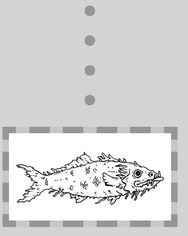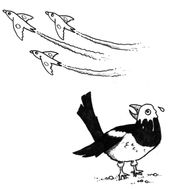chapter seven
vicious varmints
what’s the best way to fight a crocodile?
Crocodiles are one of the most enduring species on Earth, and for good reason: they are ferocious predators. If you’re faced with a crocodile, your best bet is to get away as quickly as possible. The fastest crocodiles can run at only about 11 miles (18 km) per hour, which is slower than most people can sprint, so on land a person should be able to run away from a crocodile. It could also help to run from side to side, since crocodiles are not good at making sharp turns. Furthermore, you should not be tempted to climb a tree to escape. Crocodiles are incredibly patient, and will wait under a tree for days if they are likely to get a good meal out of it.
However, these tips are really only useful if you’re confronted with a crocodile on land, which is not the likeliest scenario. Crocodiles live and hunt in the water, and it’s there that an attack is most likely to take place. If you’re attacked by a crocodile in the water, it’s said that the best thing to do is to attack its eyeballs with your fingers. Apparently, the crocodile will automatically open its jaws and let you go, since the eyes are the most sensitive part of its body.
A twenty-six-year-old man named Hillary Amuma recently tested this theory when he was grabbed by a crocodile while fishing in the Tana River in Ethiopia. The crocodile grabbed his left thigh and began to drag him into the water. Amuma says at that point he remembered the traditional Pokomo tribe method his grandfather taught him of how to fight a crocodile. He threw away his fishing gear and jabbed his fingers into the crocodile’s eyes. The animal let Amuma go, but then attacked again. Once more, Amuma attacked the crocodile’s eyes, and this time he escaped. “I just aimed my fingers at its eyes and the reptile became immobile,” he said. “The Pokomo say a crocodile fears being touched in the eyes and, once that is done, it becomes immobile and lets go. A real Pokomo man cannot be scared by a crocodile.”
what is the world’s deadliest creature?
Strictly speaking, one could argue that all animals that can kill you are equally deadly, but some are certainly more menacing, more potent, more prolific, or simply more interesting than others. For example, the spitting cobra is perhaps the world’s deadliest snake. It is found in India, where it kills more than fifty thousand people every year. It is extremely venomous, and very aggressive.
The cone shell is a small, attractive mollusk, which surprisingly turns out to be one of the most dangerous things in the sea. Touch it, and it will fire a venomous harpoon from the end of its shell that can kill you in seconds.
Another of the ocean’s most fearsome predators is the box jellyfish, which is also known as the sea wasp. It has tentacles 16 feet (5 m) long, which it trails in the water. A sting from a box jellyfish can kill a person in just a few hours.
The poison-dart frogs of the Amazon rain forest may be tiny, but each one contains enough poison to kill around ten to twenty people. The world’s deadliest spider is perhaps the funnel-web spider. Its venom can kill a person in less than fifteen minutes, and its fangs are strong enough to bite through leather gloves. It likes to live around human settlements and will attack on sight.
But for sheer number of deaths, no creature can come close to the humble mosquito. In the last two hundred years, mosquitoes have killed more people and animals than any other species, nation, or weapon on Earth, making them the deadliest creature known to man. Mosquitoes are bloodsuckers that carry microorganisms in their saliva that can cause malaria, dengue fever, encephalitis, yellow fever, and other diseases. Each year, these diseases kill more than 3 million people worldwide. Mosquitoes are found all over the world, including many cold climates. At certain times of the year, Eskimos have to cover their faces with mud to protect themselves from attack. And what’s the most exciting mosquito fact of all? Mosquitoes can dodge raindrops.
what is the toughest creature in the world?
As we have seen, mosquitoes and poison-dart frogs are pretty deadly, but they couldn’t be described as tough, and they are both fairly easy to kill. So which creature is the toughest and most resilient? Is there a creature so tough that none of these venomous killers can threaten it? Which animal can survive the harshest conditions? Here are a few contenders for the title:
Grizzly bears are pretty tough. They have no natural predators, they can eat almost anything, and they can survive for up to six months without food during hibernation. Polar bears are also tough. They too have no predators, and manage to survive in one of the most inhospitable parts of the world, with temperatures as low as minus 34.6 degrees Fahrenheit (minus 37 degrees Celsius).
Armadillos may not be an obvious choice, but they are very hard to kill. Their armor is tough and leathery, making them impenetrable to predators as dangerous as wolves, coyotes, and bears. Jaguars can crack them open, as they have immensely powerful jaws that can generate more than 660 pounds (300 kg) of pressure.
Of course, there are many kinds of toughness and resilience. Camels can lose as much as 25 percent of the water in their bodies and still survive the heat of the desert. Most animals, including humans, will die of thirst after losing just 10 percent of their water. An African lungfish can survive for as long as four years without food.
Scarab beetles can lift over four hundred times their own weight. They can even support eight hundred times their own weight on their back.
Cockroaches are famously resilient. A cockroach can survive being frozen, poisoned, or even beheaded. A beheaded cockroach will eventually die, but only because it no longer has a mouth, and so it dies of thirst. Cockroaches can survive 6,400 rads of radiation—just 2,000 rads are enough to kill a human being. It can also survive a pressure of 126 g’s, while 18 g’s will kill a person. As a species, cockroaches seem practically indestructible. They have been around for 350 million years, and one female alone can produce half a million offspring a year.
In terms of toughness, though, one creature stands alone, and yet it’s one that few people have heard of and even fewer have actually seen. The tardigrade is a microscopic animal that grows to just over a millimeter in length, and looks a bit like a woodlouse. There are more than nine hundred species of tardigrade, and they are found almost everywhere on Earth—in lakes and oceans and on land. They can swim or walk, and their loping bearlike gait is the reason for their other name, the water bear.
Although they are small, tardigrades are immensely tough. They can survive at temperatures lower than minus 418 degrees Fahrenheit (minus 250 degrees Celsius). They are effectively radiation-proof, and they can withstand pressures of more than 85,000 pounds (6,000 kg) per square centimeter, which is more than six times greater than the pressure of seawater at a depth of 33,000 feet (10,000 m). It can survive being frozen, dehydrated, or even sent into space. When civilization collapses, and all that’s left is a post-apocalyptic wasteland, the tardigrade will endure.
which spider wraps its prey to death?
Many spiders have elaborate and ingenious ways of catching their prey. Some build sticky webs for insects to walk into, or throw small webs over their prey. Others jump onto their prey, or chase it, or ambush it. One species builds a trapdoor, from which it suddenly appears as if from out of the earth. Another spider mimics ants, so that it can then eat them. One even hunts underwater. But once these predators have caught their prey, they all tend to kill it in the same, direct fashion: they bite it, paralyzing it with their venom, and then eat the body, devouring it with their sharp, powerful fangs.
Hackled orb-weaver spiders have no fangs, which means they have no way of paralyzing their prey. Instead, to kill a single moth or beetle, this spider will weave more than 460 feet (140 m) of silk, performing more than 28,000 individual wrapping movements, wrapping its prey tighter and tighter. This silk shroud becomes so tight that it breaks the insect’s legs and forces its eyes into its head, often killing it outright. The hackled orb-weaver is the only spider known to crush its prey to death in this way.
do giant squid ever sink ships?
For centuries, sailors have told scary stories about “kraken,” legendary sea monsters capable of dragging the biggest ships to the bottom of the ocean. Generally, these stories have been thought to be myths, but recent incidents have raised the possibility that stories about kraken may have referred to a real creature: the giant squid.
In 2003, a sailor named Olivier de Kersauson was attempting to break the world speed record for circumnavigating the globe, when his 110-foot (34 m) trimaran came to a sudden stop in the middle of the Atlantic. When one of the crew looked through a porthole, he saw an enormous tentacle, thicker than a human leg, trying to get a grip of the yacht’s rudder. The boat began to shake, but then the creature seemed to give up and vanished back into the ocean. One of the crew reckoned the creature must have been about 33 feet (10 m) long.
Although sea monsters of this size may sound improbable, evidence suggests that they may well exist. In the same year that de Kersauson’s yacht was attacked, scientists in New Zealand found the remains of a squid that had been caught while attacking a trawler in the waters off Antarctica. It was believed to be a juvenile of the super-squid species, Mesonychoteuthis hamiltoni. According to the research team, the size of this individual suggested that a fully grown adult could reach as much as 50 feet (15 m) in length. In 2004, researchers took the first pictures of a live adult giant squid in its natural habitat.
which fish spits its prey to its death?
The archerfish has a very impressive technique for catching its prey. It is unique among fish because it can shoot down its insect prey by squirting a precise jet of water from its mouth to knock them down from the waterside leaves and stems where they perch, to a height of up to 10 feet (3 m). The archerfish is extremely accurate, almost always hitting its target with the first shot. This is particularly impressive when you consider that the archerfish is underwater, which means that its view of the insect is refracted and distorted by the water’s surface. Somehow, the fish takes this into account when it aims.
Then, within 100 milliseconds of the insect’s being knocked off its perch, the fish will start swimming to the exact spot in the water where it knows the insect will fall. Amazingly, the archerfish can predict this landing point so accurately that it arrives to collect the insect just 50 milliseconds after it hits the water, ensuring that no other predator can sneak in and steal the fish’s meal.
which bird kicks its prey to death?
The secretary bird has an unusual way of killing its prey: it stamps its victims to death. It is an extremely tall, gangly bird that can reach 4 feet (1.2 m) in height. It can fly if necessary, but it has largely lost the habit, probably because it is so successful at hunting on the ground. It stalks across the grasslands of Africa, often walking as much as 15 miles (24 km) a day.
Its main food is snakes, which it kills by kicking them in the head with its back toe, but it also eats a wide range of other ground-dwellers, including rats and insects.
why do white-winged choughs kidnap the chicks of rival families?
The white-winged chough is native to Australia and was named by settlers after the European chough, which it resembles, although in fact the two species are not closely related. An individual white-winged chough is very much dependent on its family. It does not reach sexual maturity until it is four years old, and until that time it will usually stay with its parents. This suits the parents well because, as far as these birds are concerned, the bigger the family unit, the better.
The reason for this is that white-winged choughs survive by foraging in the leaf litter for insects, grubs, snails, and grain. This is skilled and labor-intensive work. It takes young birds a long time to learn how to find food, as much as eight months, so it is useful for the family to have as many capable helpers around as possible. This is particularly important during the breeding season, when there may be as many as four new chicks to feed, none of which will contribute significantly for a long while. For this reason, families of white-winged choughs generally need at least eight helpers if they are to raise all four of their hatchlings.
If a group manages to reach this kind of number, it may then try to expand its territory by declaring war on its neighbors. The family will go out as a group, including the immature young, and raid the territory of a neighbor, tipping its eggs and hatchlings out of the nest and destroying the nest itself, which is an attractive, carefully crafted mud bowl.
The birds may also try to kidnap the newly fledged chicks of a rival group by tempting them with offers of food. If a fledgling is persuaded by this, it will begin to accept the new family as its own within as little as half an hour. Once a chough is a month old, it is no longer susceptible to being kidnapped, which suggests that the very young chicks do not yet fully recognize their own family.
which wasp makes a spider spin it a cocoon?
There is a Costa Rican wasp, called Hymenoepimecis argyraphaga, that has an amazing way of getting its cocoon built. The process starts when the female wasp approaches a Plesiometa argyra spider. This is an enormous, fearsome spider that most insects sensibly avoid, but not this one. Instead, the wasp hovers in front of the spider, and then lands directly on it. Then it quickly brings its ovipositor forward and implants an egg on the spider’s back before swiftly flying off.
The spider seems to be unharmed, but as the egg develops, it remains on the spider’s body, absorbing nutrients from its host. The night before the wasp larva pupates, the spider will destroy her own web. So far, this is fairly normal behavior: most web-spinners regularly destroy their webs, eating the silk and thus recycling it.
However, at midnight, the spider will spin a new web, and this one will be very different from her usual orb web. This web has none of the usual features—no radial spokes and no sticky spirals. Instead, it is attached to the surrounding plants by extra-strong, reinforced threads. Unknowingly, the spider is building the last web it will ever produce. Once it is completed, the spider sits motionless underneath it and never moves again. The wasp larva has injected the spider with a chemical that first altered its web-spinning behavior and now puts it to death.
The wasp larva now feasts on the spider’s body, eventually dropping the dry, empty husk. At dawn, the wasp spins its own bright orange cocoon, which hangs inside the spider’s final web, elevated and protected from ants and Costa Rica’s heavy rainstorms.
what are siafu?
Siafu, which are also known as driver ants, Matabele ants, or safari ants, are one of the fiercest and most dangerous of all the insects. They are found mainly in Africa, where they live in large colonies. They eat a varied diet that includes insects, earthworms, termites, and sometimes even larger animals, including weak or injured mammals.
They travel in raiding parties several hundred strong. The siafu have enormous, shearlike jaws, which they carry pointing vertically downward. They march in columns, about six abreast. Alongside the soldiers run minors, which are about half their size. Earlier, a scout will have laid down a scent trail to lead them to their target, such as a termites’ nest. As they march, they “sing” by rubbing a patch of ridges on their front.
When they reach the termite hill, they will be faced by ranks of soldier termites. These are bigger than the siafu, with huge, armored heads and powerful jaws, but nonetheless they are no match for the siafu. The siafu seize the termites and quickly inject their venom into the termites’ brains, killing them within seconds. The raiders now start to make a pile of the vanquished termites.
With no guards left, the termite nest is now defenseless. The siafu storm inside, killing all the soft-bodied worker termites they can find. For a quarter of an hour, the slaughter may continue, as the pile of bodies grows. The minors now start to carry the bodies back to their nest, carrying as many as six at a time. Eventually, the army marches back home, this time singing a different song, presumably a triumphant song of victory.
do animals bear grudges?
Some intelligent animals do seem to be able to remember individuals who have somehow displeased them in the past, and behave differently toward them as a result. A recent study at the University of Florida found that mockingbirds could remember people who had previously threatened their nests, and would menace or even attack them. In the study, a group of volunteers approached the mockingbirds’ nests and gently touched the edges. They did this on a number of consecutive days, giving the mocking birds time to remember their faces. After just two days, the birds started responding differently to those individuals they recognized, giving alarm calls earlier than usual, and even defending their nests with aggressive swooping dives, sometimes grazing the tops of the volunteers’ heads. Meanwhile, new volunteers would approach the nests, but the birds would remain calm. They seemed to attack only people they recognized from previous days.
There are also accounts of elephants bearing grudges. In Uganda in the 1980s, a large proportion of the elephant population was killed for ivory. Some experts believe that those elephants that survived, many of which would have been infants at the time, may have retained traumatic memories from their childhood, causing them long-term mental anguish into their adulthood. This has led to juvenile elephants terrorizing motorists, and attacking towns and villages in what some believe to be revenge attacks.
In another equally anecdotal example, an elephant in a traveling circus was believed to have killed a woman over a lingering resentment. In Texas in 1928, the circus had come to town, and the trainer of an elephant named Black Diamond had begun a relationship with a local woman, who had encouraged him to leave the circus. The next year, when the circus returned, Black Diamond attacked the woman and killed her, in what many believed to be a deliberate act of revenge. They do say elephants never forget.
which creature is the sloth’s only predator?
Sloths are slow, sleepy creatures that spend their days hanging and eating in the treetops, and could never be described as aggressive or threatening. Nonetheless, their unusual lifestyle means that they are practically invulnerable to predators. Except for one. Amazingly, even though a sloth can weigh as much as a sheepdog, there is a bird that is capable of swooping down and carrying one off.
This bird is the harpy eagle of South America, which can also prey on monkeys. As you might imagine, it is an enormous bird, with a wingspan of as much as 7 feet (2 m). It is an expert hunter that swoops down through the trees to quickly snatch its prey. Its talons are as big as a grizzly bear’s claws and are capable of smashing the bones of its prey. They are also long, sharp, and deeply curved, and consequently impossible to escape from. When the harpy eagle swoops down to grab a monkey or a sloth, it does so by swinging its legs forcefully, stabbing its sharp talons right through the animal’s body. The force of this blow is sometimes enough to kill the animal outright. If not, the resulting damage to its internal organs will usually finish off the job. When it lands with its prey, the harpy eagle tears it apart with its hooked beak, which is as sharp as a razor. It is an extraordinarily effective predator.
which bird attacks in squadrons?
Fieldfares are one of the largest members of the thrush family and are found in Europe and northern Asia. They are fairly large birds, around 9 to 10½ inches (22 to 27 cm) long, which feed on insects, berries, and earthworms. They are sociable and collaborative birds, which often nest together in colonies. Like many birds, they alert one another to the arrival of a predator.
The first fieldfare to spot a threat, which might, for example, be a chick stealer such as a magpie, will give a call, sounding the alarm. Rather than simply rushing for cover, the rest of the birds will take up the cry themselves, so that it quickly becomes an unnerving cacophony. They then dive-bomb the predator, shrieking at it as they swoop down, before releasing a bomb of feces. Fieldfares are adept at aiming these bombs, and many of them will hit their target. The magpie may soon end up covered in feces, making it fall to the ground, where it will hop away, dejectedly, to clean itself up.
which crustacean has a hidden switchblade?
The mantis shrimp lives in shallow tropical and subtropical seas. It has an extension to its main claw that it keeps folded out of sight, a bit like a closed switchblade. When hunting, the mantis shrimp flicks open this claw extension at enormous speed and smashes it into its prey. It is one of the fastest physical movements that any animal is known to produce. A large Californian mantis shrimp, which is about 10 inches (25 cm) long, can have a strike speed of 33 feet (10 m) per second, which is about the speed of a bullet fired from a .22-caliber rifle. This strike is powerful enough to cut small fish in two or crack open the shells of crabs and shellfish. Mantis shrimps are therefore not recommended as pets, because their amazing weapon has been known to crack the side of a double-walled safety-glass fish tank.
Yet even the mantis shrimp is arguably outdone by the resourceful hermit crab, which actually uses entire creatures as weapons. A hermit crab will attach a sea anemone to the back of its shell. Sea anemones have vicious, stinging tentacles, which serve to keep any predators far away from the hermit crab.
The little boxer crab takes this innovation even further. It carries a small anemone in each of its two front pincers and brandishes them like maces. If any predator threatens the crab, it thrusts its pincers forward, wielding its two bunches of stinging tentacles. The crab never lets go of its anemones, which means it is unable to use its front pincers to pass food into its mouth, as most crabs do, so instead it has learned to use its two front legs for this purpose instead.
why do male spiders give presents to the females?
In many species of spider, the female is much bigger than the male and will eat him, given half a chance. Male spiders therefore tend to stay out of the female’s way, yet when it becomes time to mate, they have no choice but to risk an approach. However, neither the prospect nor the act of copulation does anything to soften the female’s belligerent attitude, which means that the male spider has to be alert to danger at every stage of the process. In one well-known example, the female black widow spider will sometimes kill and eat the male immediately after mating.
To protect themselves from this fate, some spiders have developed a range of crafty strategies. In some species, the male will bring the female a present to distract her. This present usually consists of a fly or some other morsel of food, wrapped in a silk thread. While the female is busy unwrapping this parcel, the male will quickly mate with her. Some males employ an even craftier trick. These devious lotharios offer the female an empty husk, a wrapped gift with nothing inside it. By the time the female has opened the parcel and discovered that she’s been deceived, the male will have already mated with her and escaped.
The male nursery web spider has developed an even more bizarre strategy for winning over the female. To attract a mate, he pretends to be dead. He stretches out his body, lying completely still, while holding a morsel of food in his mouth. The female comes to investigate the food, and may even grab it, dragging him with it. Suddenly, at this point the male will spring into action and maneuver himself into the mating position. A recent study of nursery web spiders found that 89 percent of males that played dead achieved copulation, while only 40 percent of their more vivacious rivals were successful.
The redback spider does something even more extraordinary. Rather than trying to avoid being eaten, the male redback actually encourages the female to eat him. As in most spider species, the female redback is much bigger than the male. When mating begins, the male performs a kind of somersault over the female, so that his abdomen is directly over her mouthparts, encouraging her to devour him, while the copulation continues to take place. Odd as it may sound, this behavior seems actually to help the male redback to reproduce, since males that get eaten by the female actually tend to mate for longer, and thus fertilize more eggs. Females that have already eaten one partner become less likely to go on to mate with another male. And you thought human dating was weird.
which mammal, apart from humans, engages in kidnapping, gang rape, and pointless murder?
The surprising answer is the dolphin, despite its sweet, caring reputation. Dolphins are one of the best-loved of all animals, and they are undeniably cute, playful, and intelligent. Like us, dolphins live in social groups, of up to a dozen individuals, and establish strong social bonds. Dolphins look after sick or injured companions and help them to the surface if they are having trouble breathing. Furthermore, dolphins don’t reserve this altruistic behavior solely for other dolphins: they have also been observed assisting a stranded pygmy sperm whale and her calf. They have also been known to protect humans from shark attacks, either by circling the human or charging at the sharks.
Dolphins also have a considerable dark side. Males often form groups of two or three individuals, seemingly for the sole purpose of forcing females into sex. A group of males will herd a female, sometimes for months at a time, with each of the members aggressively coercing her into sex. These groups also kidnap females from other rival groups. This kind of aggressive sexual behavior is directed not just toward other dolphins: there are also numerous reports of dolphins sexually molesting human beings. In 2002, swimmers in Weymouth, England, were warned to avoid a bottlenose dolphin named George, who had learned to isolate female swimmers, circling them and leading them away from the group, before attempting to mate with them.
Even celebrities aren’t safe. While shooting the TV series Flipper, Jessica Alba was moved to request that in future she be paired only with female dolphins, after a number of males had tried to mate with her.
Dolphins are also surprisingly violent. Male bottlenose dolphins have been known to kill their own young. Aggression between rival males is common, and older males will usually have a number of battle scars. Some dolphin violence seems to have no obvious purpose. Dolphins have been seen attacking and killing porpoises, even though the two species have very different diets and so are not competitors for food. Dolphins also gang up on smaller members of their own species. They begin by “jaw clapping,” producing an eerie, audible warning. They then attack in numbers, overwhelming the victim with bites, head butts, and powerful blows from their tail fins.
In a wide-ranging study of dolphins that seek out human company, three-quarters were seen to display aggressive behavior, sometimes leading to serious injury, and half took part in “misdirected sexual behavior” with boats and buoys as well as humans.





